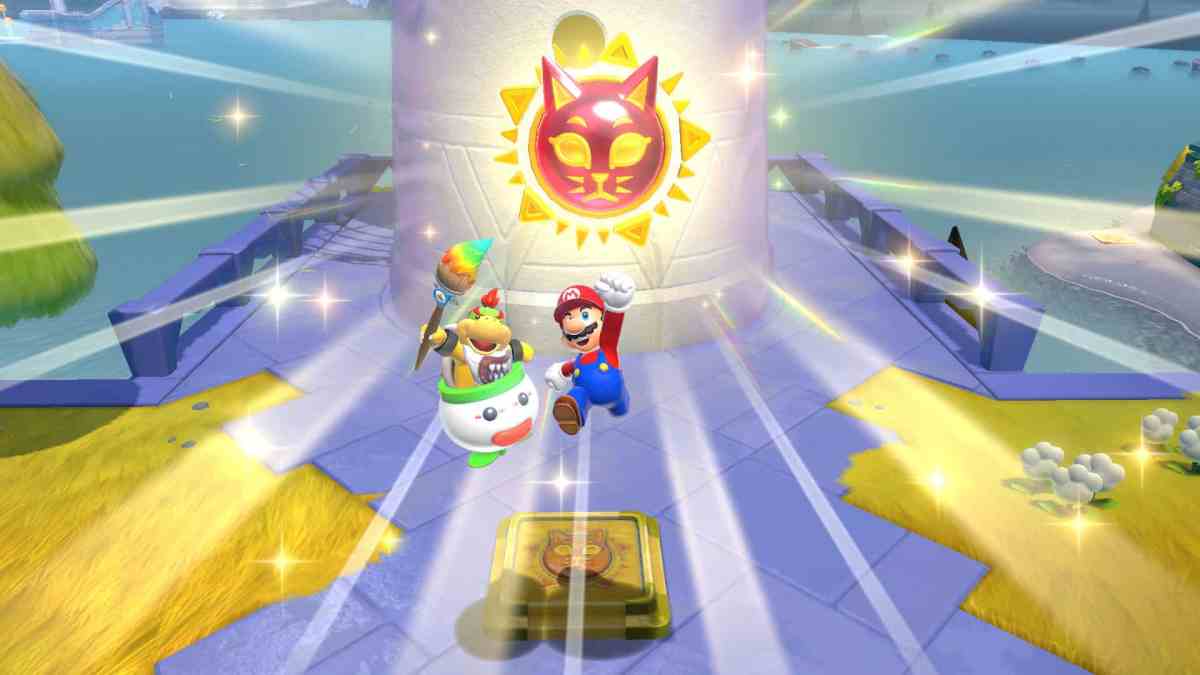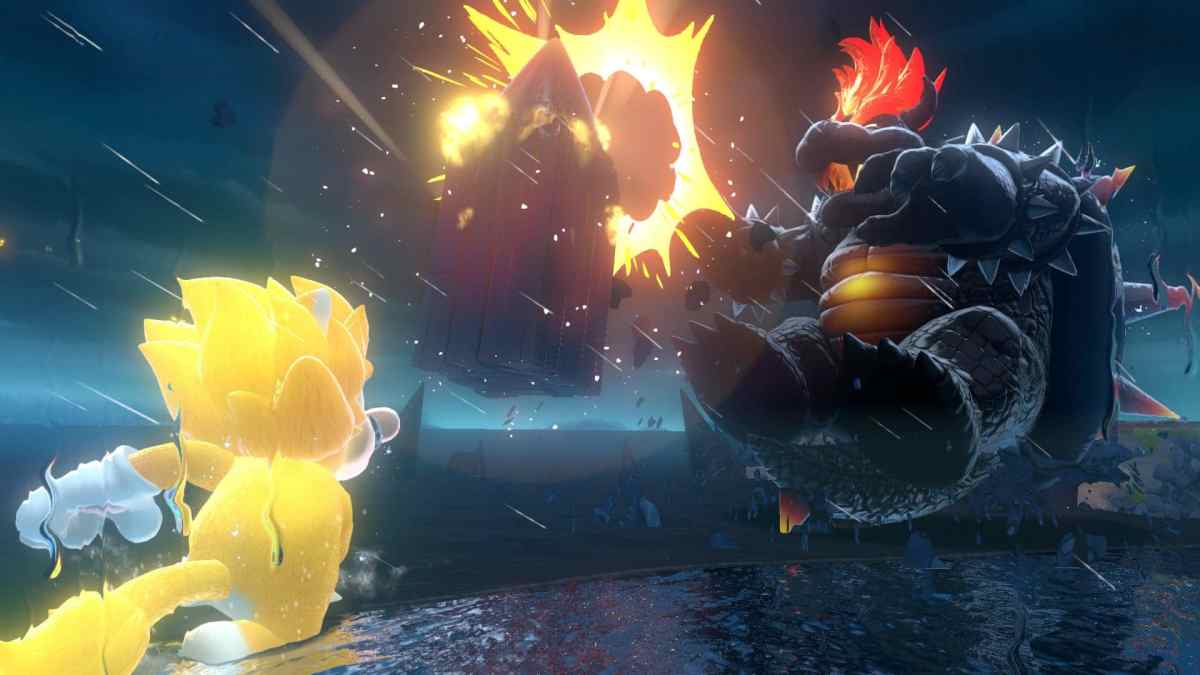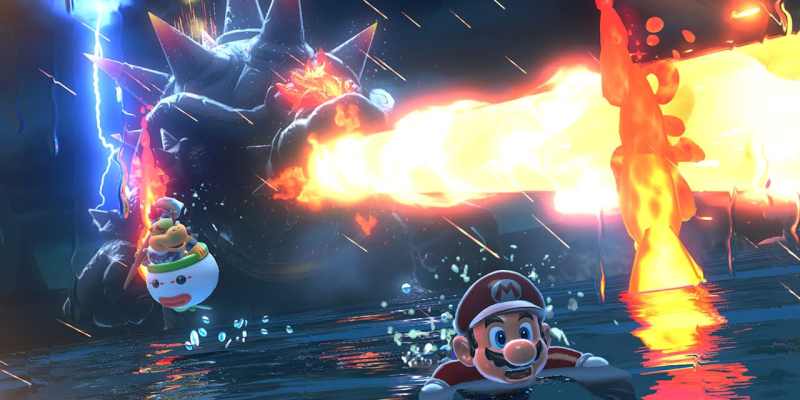Bowser’s Fury is so much more than just a simple add-on to Super Mario 3D World. It’s short, dense, and surprisingly experimental. But as another in a storied history of strange Mario side-stories, it absolutely works and is hopefully a taste of what the future of the series looks like.
On its surface, Bowser’s Fury presents a packed sandbox that pulls in some of the best elements from previous 3D Mario games. Bouncing between Super Mario 3D World and Bowser’s Fury is relatively painless, as your core move set and roster of power-ups are very similar. The way each of the main areas evolves as you collect its five Cat Shines feels reminiscent of how Super Mario 64’s stages would change slightly depending on which Star you were going after. The island vibes and sea traversal obviously recall Super Mario Sunshine. And the expansive size of Lake Lapcat, combined with the full control you have over the camera, makes it feel like one of Super Mario Odyssey’s kingdoms.
But while it might seem like a greatest hits collection at first, it’s what’s new about Bowser’s Fury that makes it stand out — and even fixes major problems I had with some of the aforementioned Mario classics. There’s a lot I love about Super Mario Odyssey, including the New Donk City festival and how Cappy took Mario’s movement to the next level. But I also felt like the game tripped into that dangerous territory where a collectathon throws too many things at you, and they ultimately stop feeling special. One of the clearest examples of this was when Rare transitioned from the perfect cocktail of tchotchkes in Banjo-Kazooie to burying players in an avalanche of doodads and trinkets in Donkey Kong 64.

In Odyssey, there were 880+ Power Moons to collect throughout the game. At this abundance, it never really felt special when you came across one. Sure, you needed them to power your ship to reach new kingdoms, but the fact that you just kept stumbling upon them, including being able to buy them at shops, took away the sense of discovery and accomplishment that came in in Mario 64 and the Galaxy games.
In Bowser’s Fury, the 100 Cat Shines spread across the map all feel immensely important thanks to how they feed into the game’s central hook. Every few minutes, Fury Bowser awakens from his inky slumber to cause carnage across Lake Lapcat. You can temporarily lull him back to sleep in one of three ways: avoiding his attacks for long enough, snagging a Cat Shine, or using a powered-up Giga Bell to transform into Super Saiyan Mario and defeat him in a quick boss battle.
Bowser’s Fury has a pair of convenient indicators to give you a clue as to how much time you have left to explore before Bowser erupts once again. You can spot his massive shell slowly rising out of the ink in the center of the map, eventually clearing the goop and waking back up. Alternatively, you can keep an eye out on the weather, as it begins to rain once your time is running short. Keeping these two factors in mind while exploring meant that I was always looking out for a Shine that I could save and easily access when Bowser would wake back up. Instead of feeling disposable like Odyssey’s Moons, they felt like genuine lifesavers.
But the really smart thing Nintendo did was to ensure Fury Bowser’s arrival is never an exclusively bad thing. Seeing him slowly rise in the distance as the weather turns for the worse brings a sense of urgency, but one that can be utilized to your advantage. While Fury Bowser does bring a heap of danger and makes precise platforming a bit tricky, you can use him to access certain parts of the world. By baiting his rage, you can direct it to open up shortcuts, blast through Bowser Blocks, and unearth a bunch of power-ups.

That last thing really stands out to me. Thirty years ago, Super Mario World introduced the idea that you get to have one power-up activated and another stored in your back pocket. But now, you can collect up to five of each type and use them whenever you need to. This leads to some neat strategies where I’d bank my fireballs and boomerangs for the arena fights and save my cat and tanooki suits for when I needed to do some precise platforming.
The item stock isn’t the only thing that makes Bowser’s Fury feel more accessible. I really appreciated the fact that you could toggle Bowser Jr.’s helpfulness in the pause menu. This ranges from him not helping out at all unless you tap the screen on a specific spot for him to paint, to him clearing out any enemies that remotely enter your orbit. Combine this with the return of Plessie, who plays as important a role mechanically in this game as Yoshi did in Super Mario World on SNES, and what you have is a Mario experience that’s absolutely brimming with life.
At the end of the day, I’m not exactly sure how to even classify Bowser’s Fury. It’s an accompaniment to Super Mario 3D World, which is finally getting the audience it deserved back when it first released on the Wii U. But Bowser’s Fury’s creativity and experimentation nearly outshine 3D World’s massive adventure. It feels familiar yet strange in the same wonderful way that Yoshi’s Island and Majora’s Mask do. Sure, it only takes five hours or so to collect every Cat Shine, but I loved every single second of that time. Maybe this is a taste of what the future of Mario has in store, or perhaps it’s a hint at a new direction Nintendo might take in delivering bite-sized, experimental games in other series. Regardless, Bowser’s Fury is one of my favorite things to come from Nintendo’s storied franchise in quite some time.
